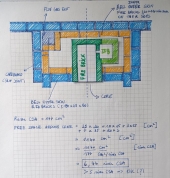posted 2 years ago
Steel for the combustion core is a bad idea. Lots of youtubers do it, but they hardly ever show how it worked a year later. People who have reported on it almost universally say the steel is destroyed within a season or two, assuming they built and operated it at proper RMH temperatures for complete combustion.
You need to use refractory materials for all of the inner core, whether castable or firebrick or ceramic fiber. You can use steel as an outer form to contain the insulating core material, but there is no advantage to using welded heavy steel for that. Sheetmetal works fine.
A 15" diameter bell over the heat riser is cutting it close for clearances. A 6" system with a 1" ceramic fiber riser will have an outside diameter of 8" or so, leaving an average of 3 1/2" clearance all around. Any bulkier riser material, especially firebrick, will barely be able to fit inside a 15" barrel at all. A standard and cheap 55 gallon barrel works fine and will last plenty long. You don't need heavy steel for this part.
If you want to use your existing cylinder for a bell, there is practically no such thing as too much height. A 6" J-tube may well heat your 60 m2 (600 ft2) space fine, depending on your climate. How cold does it get, and for how long? How well insulated is your space?
If you use standard firewood (generally 16" in the US), you would want the feed tube of your core the same depth so the wood fits completely inside it. This is important for emergency capping as well as for regular partial covering to regulate air supply. Following what I like best for proportions and using US standards, 1:1.5:3 would give you a 16" feed tube, 24" burn tunnel floor, and 48" heat riser. This is just barely possible to fully clean ashes from using a short scoop/rake as long as you don't have huge hands. You would have a 12" burn tunnel ceiling which would give plenty of working clearance with your metal bell.
Firebrick for the feed and burn tunnel, insulated all around, with a 5 minute riser (1" ceramic fiber blanket fitted inside a sheetmetal jacket) on top of the firebrick, would work well for your situation. You don't need to be an experienced mason for this, you can lay up the firebricks dry as long as you hold them in place with a sturdy containment.







